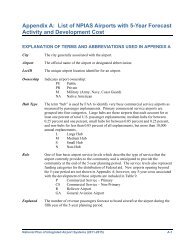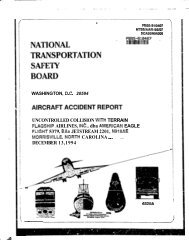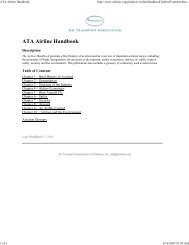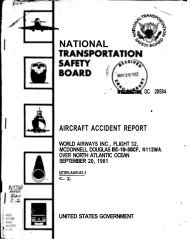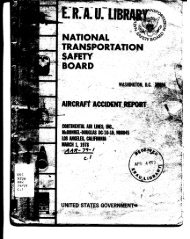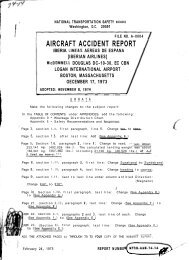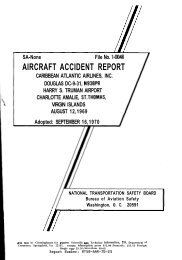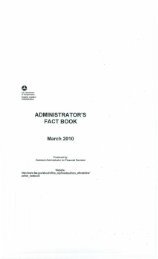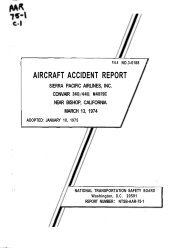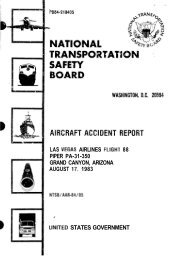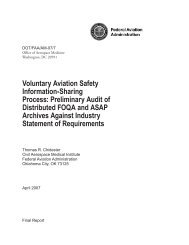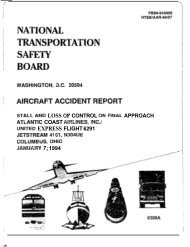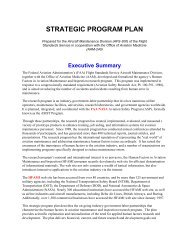NTSB/AAR-70/28 - AirDisaster.Com
NTSB/AAR-70/28 - AirDisaster.Com
NTSB/AAR-70/28 - AirDisaster.Com
Create successful ePaper yourself
Turn your PDF publications into a flip-book with our unique Google optimized e-Paper software.
I<br />
I<br />
I 1.<br />
1.1<br />
I 1.2<br />
1 t:;<br />
1.8<br />
1.9<br />
1.10<br />
1.ll<br />
1.12<br />
I1.13<br />
1.14<br />
1.15<br />
2.<br />
2.1<br />
2.2<br />
1 2 :<br />
TMAS INTERNATIONAL AIRTJNES, INC.<br />
DOUGLAS E-9, Nl308T<br />
HARKCNGR?, TMAS<br />
JANUARY ll, 190<br />
TAELE OF CONTENTS<br />
Synopsis...............<br />
Probable Cause . . . . . . . . . . . .<br />
Investigation . . . . . . . . . . . . .<br />
* - - *<br />
Injuries to Persons . . . . . . . . . . .<br />
History of Flight . . . 0<br />
Damage to Aircraft . . . . . . . . . . . . .<br />
OtherDamage. . . . . . . . . . .<br />
migatmew rnfarmation . . . . . . . . . .<br />
Aircraft Information . . . . . . . . . . .<br />
Meteorological Information . . . . . . . . .<br />
Aids to Navigation . . . . . . . . . . . .<br />
<strong>Com</strong>munications . . . . . .<br />
Aerodrome and Ground Facilities .<br />
.<br />
.<br />
.<br />
. . .<br />
Flight Recorders . . . . . . . . . . . .<br />
Aircraft Wreckage . . . . . . . . . . .' .<br />
Fire . . . . . . . . . . . . . . . .<br />
SurvivalAspects . . . . . . . . . . . .<br />
Tests and Research . .I . . . . . . . . . .<br />
Analysis and Conclusions . . . . . . . . . .<br />
Analysis . . . . . . . . . . . ... . 0<br />
Conclusions . . . . . . . . . . . . . .<br />
(a) Findings . . . . . . . . . . . . .<br />
(b) Probable Cause . . . . . . . . . .<br />
Recammendations and Corrective Measures . . . . .<br />
Appendices<br />
A. Investigation and Hearing<br />
1. Investigation<br />
2. Hearing<br />
3. Preliminary Report<br />
B. Harlingen Approach Chart<br />
C. Flight Recorder Dsta Graph<br />
D. Letter to Honorable JON H. Shaffer, Administrator,<br />
Federal Aviation Administration, dated November 20,<br />
19<strong>70</strong>
SI3 71-7<br />
(202) 426-8787<br />
Office or the klyirman<br />
The Sational Transportation Safety lloard released tday its<br />
report on a predawn approach accident in which a Texas Inter-<br />
national Airlines Ilouglas Dc-9 nearly crashed on approach to<br />
Ilarlingen. 'Texas. on January 11. 1!'<strong>70</strong>.<br />
The aircraft struck a 30-to-35-foot-hiph tree and two ?!'-foot<br />
power poles more than two miles short of Ilarlingen Industrial<br />
Airport. The crew &as able to abort rhe approach, climb awag,<br />
and continue safely to a landing at Houston even though the sub-<br />
.stantially damaged Dc-9 was carrying pieces of tree. pole and<br />
wire Imbedded in its underside. Ilarlingen visibility at the time<br />
of the approach, 0<strong>70</strong>0. was reported as one-half mile in fog.<br />
All il persons aboard the aircraft escaped injury.'<br />
The Safety Board determined that the probable cause was . .<br />
,*<br />
. . . the continuation of the descent, during actual<br />
instrument conditions, through the Ninimum Descent<br />
Altitude and into ground obstructions as a result of<br />
inadequate flightcrew monitoring of the aircraft<br />
altimeters. A contributing factor was a lack of<br />
awareness by the flightcrew of the actual meteorological<br />
conditions, caused by crew fatigue. and<br />
company workload p r i o r i t i e s w e d<br />
normal air-to-ground communications and deferred<br />
the dissemination of essential meteorological<br />
.I<br />
information.<br />
The Safety Board's investigatiqn showed that the captain and<br />
first officer had logged 4335 hours of flight time the day before<br />
.
-2-<br />
the accident. 'I'ltcy Itad remained overnifltt at .UcAllen -- departuro<br />
point for SLc.\llen-lIarlin~tn-Ilon~ton-lhllas FliEht 926. Rut they<br />
could have lad only about fowr hours' sleep before the accident<br />
flight, the Board found. The plots had arrived at the Mc..\llen<br />
airport at the 0630 scheduled departure time for Flight 926. and<br />
in about 2t minutes performed their pre-flight duties. taxiied out<br />
and took off. The Ihard held that hth the rest period and the<br />
flight preparation had been "inatlcquate. .,<br />
The llarlingen weather report receired by the captain before<br />
the takeoff from McAllen was an 0500 report of clear skies and<br />
visibility of five miles. An 0600 repnrt of one-mile visibility at<br />
Harlinqen was not made to IlcAllen because .. of "the heavy workload<br />
at the company's Ilarlingen station. the Hoard said. Thus<br />
noth the captain and the first officer, who was flying the 25-mile<br />
Xlc.~llen-llarlingen segment, were "not aware of the actual weather<br />
conditions at ilarlingen" when they began their approach, the Board<br />
found.<br />
'hring the descent, the first officer was primarily occupied<br />
with establishing and maintaining proper heading and -- believing<br />
visibility to be about five miles -- .. locrkiaq out of the cockpit<br />
.I<br />
for airport lights, the Board said. "The variance of altitude<br />
I.<br />
during this period, as shown by flight dam recorder evidence,<br />
,a. ..<br />
Indicates inadequate monitoring and control.<br />
The captain. who during cruise had been unable tn contact<br />
his company's llarlinaen station, did mahc radio contact during<br />
the approach. l'olrl chat Ilarlingcn at 0655 had half-mile visibility<br />
in fog, the captain replied that the last weather the crew had<br />
received was clear skies and five miles, and Flight 326 was then<br />
on final approach. It was at abou: this poinr. the Board determined.<br />
that the captain ordered the first officer to level off. The Board<br />
said it believes the order was given by the captain "as a result<br />
of his receipt of the new weather information. " Impact with the<br />
tree and poles came a fer seconds later.<br />
The Board's invest,igation developed w failure or malfunction<br />
of the aircraft. its powerplants or systems. Flight data recorder<br />
evidence showed that the aircraft had been within 130 feet of known.<br />
assigned or published altitudes from takeoff at McAllen to landing<br />
at Houston. Investigation and testing of ho possible sources of<br />
out-of-tolerance leakap in the aircraft static pressure systems<br />
led to a Boprd conclusion that neither would have had "appreciable<br />
effect" on the cockpit altimeter readings.<br />
Findiog that some altimeters in Tam International aircraft<br />
bore low-altitude warning markings but others did not, the Sofety<br />
-<br />
.- I
..<br />
- 3 -<br />
Board on Sovember 20, 19<strong>70</strong>. recommended that the Federal<br />
Aviation Administration consider requiring standardization of<br />
such markings on all instrcments in an air carrier or air taxi<br />
operator's fleet. FAA agreed that pilots should be able to expect<br />
I,<br />
standardization of critical flight instrument presentations." and<br />
said it was "carefully considering" how this could be achieved.<br />
The Hoard also noted that FA4 had raised Tesas International's<br />
landing minimums aher the accident, and that the carrier had<br />
taken steps "to improve and increase pilot proficiency. ..<br />
. .<br />
. .<br />
6 -
Adopted: Decuber 2, 190<br />
NATIOXAL TRANSPORTATION SAFZTY L?QARD<br />
WASW!CMN. D. C. 20591<br />
File no. 1-ooCe<br />
7
1.1 Histpry of Fliqht<br />
. .. ~<br />
Texas Tnternationnl Airlines (TXI)' Fllqht 96 is a re&.arly I L<br />
schedded doaestic pessenjer/ear%o flight which operates betseen<br />
McAllen. Texas (m), and ikllas, Teras. with ochednled en rode stops I<br />
at Harlilyen (m) and bustan, Texm (IAH). "he flig3t originates at f<br />
Mc4llen and the aircraft and cmw are the a ~ tbat ~ e teininate %n KcAllen<br />
in the late afternoon of the previous day and remain overnight. Sched- m i<br />
uled departure of TXI 96 is 0630. 1<br />
Cn January 11, 19<strong>70</strong>, the fl#&creu of MI Flight 96 nrrived at .' '- i<br />
the NWen Airport about 0630. The captain stated tbst upm llis arrival i<br />
'at the airport, he ". . . vent, to Opemtions, sigled w release, ckecked<br />
i<br />
tie weather and got eU the wailable %:ht Pclpus." The flrst officer ~ i<br />
@/O) checked the airplane. "he fliatcrev .then 5et in the cockpit, ran i<br />
i*<br />
b hecklists, and started engires. In a stntenent dated Jan- 13, lg0,<br />
i<br />
e captnin stated, '%e received our cleaiance f'rrm .W at the ranp wMch<br />
' c leared to V-2S mintsin 2(?00 feet,' set our altimeters, accau-<br />
.plished oar check lists, etc. Departure was normal rrith the F/O at the<br />
controls for this seaent." me flight. took off at E.FE ebout C65l.<br />
did~not :have M ultlaeta setting fmm t:?e Ccmpany and I dcn't believe<br />
-r<br />
f
- 3- k'<br />
"Mments later we incurred a bump, a thud, as if a bird had hit<br />
that's what it sounded like or felt like to us, it wasn't a real<br />
one. Then I said, 'lets get out of here, missed approach, they<br />
en't got it'. We executed a missed approach to the left, ran our<br />
cklist, climbed to our missed approach altitude and proceeded to the<br />
. I advised Brownsville approach, we had made a missed approach and<br />
quested clearance to Houston."<br />
The first officer stated: 'we ran the Before Takeoff as per<br />
cedure and we were ready to go. McAllen cleared us for takeoff for<br />
right turn out on course. We climbed out, I was flying and after<br />
an-the After Takeoff we turned on course. I seem to recall some<br />
8 sticking up north of tarn, but I can't say for sure because it was<br />
. I made a right turn intercepted victor 20 south and proceeded on<br />
tain Capps called McAllen and reported level at 2000. Later<br />
called BRO and got a clearance for an approach to RRL. We<br />
approach and descent checklist and we started letting down to<br />
e for crossing the VOR (1600). After crossing the VOR, we<br />
et dam to OUT minimum approach altitude which without the<br />
'8 altimeter setting, I believe, is 635. With Bramsville's<br />
eading, its minimum is 680. The checklist had been m,<br />
ch and descent and everything was looking real fine.<br />
"As I was making the approach, the Captain started calling out our<br />
o me at about 500 feet above minimums and he proceeded to do<br />
h 100'. As I approached within probably 100' minimum altitude,<br />
tain'told me, "Gib, hold it there'. So I leveled off and<br />
after this, we had a bump. It was nothing more than a - I'd<br />
se bumps on the road, I know that. The Captain then told me, let's<br />
of here. I pushed the throttles forward, pitched up to 15 and<br />
a missed approach."<br />
., BRO Apc cleared Flight 926 to Houston Intercoptinental Airport (M)<br />
an altitude of 23,000 feet. As the flight was approaching 12,000<br />
in the climb to 23,000 feet, the cabin pressurization warning light<br />
on. The crew requested U,OOO feet cruise altitude, which was<br />
ved, and proceeded to Houston at that altitude.<br />
o passengers, sitting on the left side of the aircraft, called a<br />
ess' attention to a "gash" in the leading edge of the left wing.<br />
stewardess advised the captain of this condition. Shortly afterward,<br />
first officer came to the cabin, visually inspected the wing, and<br />
returned to the cockpit to continue the flight to Houston. A paser<br />
later stated that the man who came back to look at the hole got<br />
of the right seat.<br />
eather minimums for landing.<br />
sville Approach Control was unable to obtain the latest Harlingen ~<br />
er.. Flight 926 did not request the Brownsville altimeter seB3ing<br />
none was provided.<br />
amaville Approach Control.<br />
i<br />
'!
~ left<br />
-rr 1.3<br />
When the flightcrew lowered the landing gear during the approach<br />
to land at Houston, the hydraulic system low pressure warning lights<br />
came on and an unsafe condition was indicated for the nose gear and<br />
main landing gear. The crew extended the landing gear using the<br />
manual extension procedure and a safe-to-land gear indication was<br />
obtained for all landing gears, About 0810 the aircraft landed safely<br />
at Houston.<br />
After the aircraft rolled clear of the landing runway, the crew<br />
stopped on the taxiway and maintained engine power on until ground per-<br />
sonnel could install safety pins in the landing gem linkage. When the<br />
landing gear safety pins were in plsce the engines were shut down and<br />
the aircraft was tawed to the terminal where the passengers and the crew<br />
deplaned in a n o d manner.<br />
1.2 Injuries to Persons<br />
There were no injuries to the four crewmembers or to the 37 paslksengers<br />
on board.<br />
Damage to Aircraft<br />
Several pieces of tree limbs and pieces of telephone poles were<br />
found embedded in the tears and holes. A piece of copper wire, with an<br />
insulator attached, was embedded in the leading edge of the left wing<br />
and trailed over the top and bottom of the wing.<br />
1.4 Other Wage<br />
Other damage occurred in proximity to the home of a ground witness.<br />
This home is located about 12,000 feet short of the threshold of Runway<br />
13 at Harlingen Industrial Airport, approximately on the 108" radial of<br />
the HRL VOR. A hackberry tree about 30 to 35 feet tall, in the back-<br />
yard of the home, was destroyed. Two power poles 29 feet high, located<br />
in front of the home, had about 4 to 6 feet of their tops broken off,<br />
which necessitated the replacement of both poles and several hundred<br />
feet of utility wires. A jeep parked at the residence sustained a<br />
shattered windshield.<br />
Captain Jerry Eugene Capps, aged 40, holds ATR Certificate No.<br />
1243323, AMEC, with ratings in Convair 240, 340, 440, E-3, cv-600,<br />
and X-9 aircraft. He also holds commercial privileges for &Et. Ills<br />
total flight time was 15,715 hours, with total time in the E-9 of 818<br />
Harlingen very high frequency omnidirectiod radio range.
-5- Y<br />
hours. His last line check and proficiency flight check were passed<br />
satisfactorily on April 14, 1969, and December 3, 1969, respectively.<br />
ms last first-class medical examination was passed satisfactorily on<br />
July 25, 1969, with no limitations or waivers noted.<br />
First Officer Gerald Forest Gibbons, aged 35, holds <strong>Com</strong>mercial<br />
Pilot Certificate No. 13<strong>70</strong>654 with airplane single-and multiengine land<br />
and Instrument rating. His total flight time was 7,363 hours, with<br />
total time in the W-9 of 454 hours. His last line check and proficiency<br />
flight check were passed satisfactorily on October 2, 1969, and IYovember<br />
4, 1969, respectively. €Es last first-class medical examination was<br />
passed satisfactorily on September 15, 1969, with no limitations or<br />
waivers noted.<br />
Crew Activities<br />
4,o~&&35 :ianaaxb,w3the<br />
~di3Sn about .LT@ on<br />
:as the erar-of !UI FUght 967 which tenuinated at McAllen.,<br />
The TXI Harlingen Station Manager and his wife, the captain, the first<br />
officer, both stewardesses, and the parents of one of the stewardesses<br />
spent the evening of January 10 in Mexico where they.dined together.<br />
Both stewardesses and the one stewardess' parents returned to<br />
McAllen about 2230. According to the TXI Aarlingen Station MaimP"g<br />
he and his wife<br />
m.., ,. . 888 based aWI4?4kUm 8W the oaphin and the fipt Officw<br />
ar -:*-om+#, &el between and<br />
arin the8 at that time.<br />
The first officer stated in part: "We all reported darn to the<br />
motel office to leave for the airport . . . This was probably at<br />
6:OO or right close to it, and the Captain hadn't returned yet. The<br />
hotel took us to the airport."<br />
An extensive investigation into the flightcrew's activities on<br />
the night of January 10 accounted for all their activities and whereabouts<br />
except during the period between midnight and about 0415 on<br />
January ll, 19<strong>70</strong>.<br />
A "XI Convair 600 flightcrew.
-/<br />
1.6 Aircraft Information<br />
-6-<br />
Douglas E-9-31, Iil308T, is awned by General Electric Credit<br />
Corporation and operated by Texas International Airlines, Inc. The<br />
aircraft manufacture date is December 15, 1968. The aircraft had<br />
accumulated a total flying time of 2,<strong>28</strong>1 hours. The last major<br />
maintenance inspection was accomplished on December 30, 1969. This.<br />
inspection included a test of the pitot static system. The inspection<br />
was satisfactory, with no discrepancies noted.<br />
The aircraft maintenance inspection records and the aircraft logbook<br />
pages for December 1969 and January 19<strong>70</strong> were reviewed. Particular<br />
emphasis was placed on repeat/trend type items and discrepancies covering<br />
the pitot/static/alltimeter systems. This review disclosed no qpen<br />
or uncorrected discrepancies, no "trend" type items, and no prior mal-<br />
Punctions of the aforementioned systems or their components.<br />
Meteorological Information<br />
11.7<br />
' There is no Weather Bureau station at Harlingen, Texas. Harlingen<br />
weather observations are made by Texas International Airlines personnel<br />
and sent via teletype to other stations. These observations are made at<br />
5 minutes prior to the hour and transmitted on the hour. The following<br />
observations were made at Harlingen on January 11, 19<strong>70</strong>:<br />
0455 clear, 5 miles visibility with fog<br />
0555 clear, 1 mile visibility with fog<br />
0655 partial obscuration with 112 mile visibility in fog,<br />
temperature 48"F., dew point 47"F., wind 310" at<br />
6 knots, altimeter setting 29.91.<br />
(The 0455 observation was with the flight papers for TXI Flight<br />
926. The 0555 observation was not.)<br />
Mr. Elder Black, a TXI employee at Harlingen, stated in part:<br />
"The six o'clock weather was taken by Joe Reyns, but was not sent due<br />
to being rushed by telephones, ticket counter, and trying to get pas-<br />
sengers checked in."<br />
Mr. Joe Reyna, a TXI employee at Rarlingen, stated in part: "I<br />
came on duty at 6:OO am, checked the weather with Mr. Black, we both<br />
agreed that we had about one mile visibility, with the sky and stars<br />
visible. Mr. Black had already sent the weather report . . . " Mr. Reyna<br />
f'urther stated: "The Mwen agent, Mr. Johnny Vasquez, advised me<br />
that flight 926 was trying to contact us on the company radio, I then<br />
went to the operations room to monite (sic) the radio. I called for<br />
flight 926, and they answered immediately, flight 926 asked what our<br />
late weather was so I gave them the 0655 observation, which I had just<br />
taken. I advised 926 that Harlingen had -X skies and about 1/2 mile<br />
visibility with fog. I gave the wind direction as 30 degrees at six<br />
knots. Flight 926 then replied that the last weather they had was clear<br />
Partial obscuration - sky more than 1/10 but less than 10/10 obscura-<br />
tion.
-7-<br />
skies and five mile visibility and that he was on final . . . about<br />
five minutes later I heard the flight going over. "<br />
The weather at MFE (35 miles west of HKL) at the time TXI 926<br />
departed was: sky partially obscured, visibility 1/4 mile in fog.<br />
TXI 638 departed MFE about 1 minute prior to TXI 926 and reported<br />
the top of the fog was <strong>70</strong>0 feet m. s .l. and clear above. The<br />
captain of TXI 638 made an IFR approach to Harlingen Industrial Airpark<br />
(which was missed) a few minutes after TXI 926 made its approach. He<br />
stated: "The cloud tops were 450' MSL on altimeter."<br />
The ground witness whose tree was struck by Flight 926 stated<br />
that after the impact he went outside and "it was so fo0g.g I couldn't<br />
see more than 50 yards." He also stated that it was dark and he had<br />
his house lights on until the aircraft struck the parer poles and the<br />
lights went out. He said that both of the electric clocks in his house<br />
had stopped at 7 o'clock.<br />
The altimeter setting at McAllen was 30.01 at 1<strong>70</strong>0 on January 10,<br />
19<strong>70</strong>, the approximate time that the crew landed to terminate Flight<br />
967. 2/<br />
1.8 Aids to Navigation<br />
The Harlingen (HRL) VOR is located 8.1 miles from the threshold<br />
of Runway 13 at Harlingen Industrial Airpark. The inbound radial from<br />
the WR to Rurrway 13 is 108". The accident occurred approximately on<br />
this radial.<br />
The Jeppesen Approach Chart available to the crew for the VOR<br />
approach to Runway 13 at Harlingen (see Appendix B) shows the airport<br />
elevation is 35 feet. The VOR crossing altitude inbound is 1,600 feet<br />
m.s.l., and the minimum descent m.s.1. altitude and minimp-visibility<br />
for a E-9 aircraft making a circle-to-land approach ar8600 - feet,ynd<br />
1 1/2 mile$, respectively, using the Harlingen altimeter setting or<br />
68O~~feet and 1 1/2 miles, respectively, when the Brarnsville altimeter<br />
setting is used.<br />
-<br />
On January 11, 19<strong>70</strong>, the Bramsville CS/T reported that the<br />
HliL VOR was operating normally.<br />
1.9 <strong>Com</strong>munications<br />
There were no reported technical difficulties with communications.<br />
The crew did encounter Borne operational difficulty when trying to contact<br />
the TXI <strong>Com</strong>pany radio at Harlingen where all of the TXI personnel were<br />
busy in connection with the anticipated arrival of TXI Flights 926 and<br />
638.<br />
lOJ Mean sea level.<br />
The same aircraft and crew were used for Flight 926 of January ll.<br />
l2J Br-ville <strong>Com</strong>bined Station and Tower Facility.
-8-<br />
1.10 Aerodrome and Ground Facilities<br />
Harlingen Industrial Airpark has no control tower. IFR traffic<br />
into and out of FIarlingen is controlled by Bramsville Approach Control.<br />
1.U Flight Recorders<br />
KL308T, Flight 96, was equipped with a Fairchild Model AlOO cockpit<br />
voice recorder (m), S/N 1388. This recorder was removed and sent to the<br />
National Transportation Safety Board, Washington, D. C., for examination<br />
and evaluation of the tape, The CVR contains approximately a 30-minute<br />
supply of tape in a continuous loop. When electrical power is applied<br />
to the CVR, the tape is erased immediately prior to passing over the<br />
recording heads. Therefore, only the last 30 minutes of conversation<br />
and sounds, prior to power interruption, are recorded on the tape. The<br />
aircraft was flam for over an hour after the accident occurred. Electrical<br />
power was continued on the aircraft after the landing at Houston,<br />
$nd subsequently electrical power was applied to the aircraft by ground ,<br />
phrsonnel while the CVR circuit was energized and the recorder was still<br />
installed; therefore, no useful information could be obtained i2.om the<br />
voice recorder tape.<br />
Nl308T was equipped with a Fairchild flight data recorder (FDR),<br />
5424-502, SIN 5034. The magazine from this recorder was removed and<br />
sent to the National Transportation Safety Board, Washington, D. C., for<br />
examination and a tape readout of that portion of the flight record per-<br />
tinent to this accident. The findings of the readout, based on the<br />
latest available calibration data, disclosed that the altitude and air-<br />
speed parameters were out of calibration on the high side by a significant<br />
amount (see Section 1.15 Tests and Research). A data graph was prepared<br />
from the readout of the accident flight record (see Appendix C).<br />
1.12 Aircraft Wreckage<br />
Not involved. Small miscellaneous pieces of the aircrafi - mostly<br />
wing and fuselage skin - were found at the accident site.<br />
-<br />
1.13 Fire<br />
Not involved.<br />
1.14 Survival Aspects<br />
Not involved.<br />
1.15 Tests and Research<br />
Altimeter/Static System Tests
- 9-<br />
systems by removing the caps from the drain port lines within the nose<br />
gear wheel well (unpressurized area) and fastening the test set to the<br />
ports in turn. The static ports were taped over. Leaks in excess of<br />
275 feet per minute (f.p.m. ) in both systems were encountered. Maximum<br />
allowable leakage is 175 f.p.m. TXI mechanics stated that they had<br />
previously had difficulty with certain aircraft in securing an airtight<br />
connection between this test set fixture and the static drain ports.<br />
The test set was removed and the drain ports recapped. The captain's<br />
and first officer's altimeters were removed from the aircraft and the<br />
test set connected to the lines normally fastened to the two altimeters.<br />
At this point, one of the mechanics assisting found that the "B" nut<br />
employed to fasten the captain's static line to the starboard static<br />
port in the forward cargo compartment (pressurized area) was not<br />
properly torqued. The "B" nut was tightened 3/4 of a turn which<br />
properly torqued it, Notwithstanding this correction, both systems<br />
still had out-of-tolerance leaks. It was determlned that the source<br />
of leakage was at the static drain port caps in the nose gear wheel<br />
well area.<br />
The test equipnent was removed from the altimeter connecting lines<br />
and new altimeters were installed. The test equipment was then reconnected<br />
to the drain ports in the nose gew wheel well after the<br />
caps were removed and a small thin piece of Teflon tape was wrapped<br />
around the threads prior to torqueing the test fitting. By use of this<br />
procedure the captain's and first officer's NORM&, ALTERNATE, and<br />
AUXILIARY static pressure systems were tested. All systems were within<br />
allowable tolerances.<br />
Both altimeters removed from the aircraft were bench tested in<br />
accordance with the Kollsman Instrument Corporation Service Manual.<br />
The accuracy of the altimeters was within the manufacturer's specifica-<br />
tions. Neither altimeter was marked with low altitude warning markings.<br />
All nine NORMAL, mEFNATE, and AUXILIARY static pressure syste-<br />
drain points were checked for the presence of moisture. None was noted.<br />
A heat test of all NOW, AIXEKNATE, and AUXILIARY static ports on the<br />
left and right sid,es of the fuselage was conducted. All ports were hot<br />
to the touch. Static port heater current draw indicated 9 amperes on<br />
the cockpit ammeter, which is pormal for this system. A heat check was<br />
performed on the captain's and first afficer's auxiliary and alternate<br />
Qitot tubes. All were hot to the touch and indicated normal current draw<br />
tin the cockpit smmeter. A heat check was also performed on the RAT 9<br />
probe and was found to be hot to the touch.<br />
Because of the leakage at the static pressure system drain fitting<br />
caps located in the nose gear wheel well, the Douglas Aircraft <strong>Com</strong>pany<br />
was asked to determine what effect this would have on the altimeter<br />
A crosshatching pattern or similar marking to indicate altitudes<br />
from 0 to 1,000 feet.<br />
R B air ~ temperature.
-10-<br />
indications in the cockpit. In response to this inquiry, Douglas<br />
representatives stated: "A detailed flow analysis was therefore made<br />
of the E-9 static system, assuming the leakage associated with a<br />
missing drain fitting cap in order to determine the magnitude of the<br />
error in indicated altitude. The results indicate that . . . at<br />
typical approach conditions with the landing gear retracted and having<br />
the cap entirely missing from the static system drain fitting . . .<br />
the barometric altimeter connected to that static system will indicate<br />
an altitude that is approximately <strong>70</strong> feet higher than normal. The<br />
remaining barometric altimeter, if connected to an integral statia<br />
system, will indicate normally. It is noted that if the subject cap<br />
is simply slightly loo'se, rather than entirely missing, the error<br />
11<br />
will be significantly less. . . .<br />
Flight Data Recorder Tests<br />
As previously noted in Section 1.ll Flight Recorders, the FDR read-<br />
2 out, based on the current calibration of the recorder, dated May 23, 1969,<br />
\ disclosed that the altitude and airspeed parameter recordings were<br />
.( indicating on the high side. As an example, measurement of the zero<br />
a3rspeed position was 1.769 inches from zero reference on the recording<br />
compared with the current calibration level of 1.755 inches, thms refleeting<br />
a difference of 164 knots. This difference was seen to decrease<br />
as the airspeed increased. Table I, following, presents measured values<br />
of altitude on the ground at McAllen and Houston using the M ~ J 23, 1969,<br />
calibration. Recorded pressure altitude is based on the standard barometric<br />
pressure of 29.9 inches of mercury (I@) which is the base setting<br />
of the recorder altitude sensor. Corrected m.s.1. altitude is based on<br />
the actual barometric pressure of 29.86 inches of mercury, the actual<br />
altimeter setting at both stations.<br />
Houston<br />
Intercontinental<br />
0.239 in. 725 ft. 675 ft. 98 ft. 1577 ft.<br />
Because of the marked disparity noted in the altitude and airspeed<br />
parameters in relation to the M ~ J 23, 1969, calibration, the subject<br />
flight recorder' and the foil medium containing the flight record in<br />
question were forwarded to the manufacturer, Fairchild Industrial<br />
Products, for examination and determination of the recorder calibration<br />
as it then stood. This examination was conducted on January 29, 19<strong>70</strong>,<br />
at the Fairchild facilities in Los Angeles, California, and a new calibration<br />
was obtained which corroborated the condition noted above. The
ecorder condition was not altered in any form during this exmination,<br />
The altitude and airspeed data obtained during the original readout were<br />
recomputed using the recorder calibration received from Fairchild.<br />
Subsequent to the Fairchild examination, arrangements were made<br />
with Texas International Airlines to install the recorder in an aircraft<br />
on a regularly scheduled flight with the Investigator-in-Charge of this<br />
accident riding in the cockpit to monitor and record altitudes and airspeeds<br />
during the flight. The test was conducted on Texas International<br />
Airlines Flight 915, February 17, 19<strong>70</strong>, between Love Field, hllas, Texas,<br />
and Houston Intercontinental Airport, Houston, Texas, with one en route<br />
stop at Jefferson County Airport, Beaumont/Port Arthur, Texas. The aircraft<br />
was a Douglas Model E-9-30, N8961. A previously mused spool of<br />
foil recording medium was installed in the recorder. The foil medium<br />
was removed at termination of the flight and was forwarded, together with<br />
the flight log prepared by the Investigator-in-Charge, to the National<br />
Transportation Safety Board for examination and readout of the test fligh*<br />
data.<br />
Readout of the recorder test flight record was perfomed separately<br />
on the two flight segments. The readout time periods were 38:30 minutes<br />
and 24:OO minutes respectively for Love Field - Jefferson County Airport<br />
and Jefferson County Airport - Houston Intercontinental Airport. Results<br />
of the readout reflected that the recorder retained the identical disparities<br />
noted in the original readout of the accident flight record.<br />
The zero airspeed position was measured as 1.769 inches from zero reference<br />
and the recorded altitudes at each airport were determined to be<br />
high based on the current calibration. Table 11, following, presents<br />
measured values of altitudes on the ground at the three airports noted<br />
above. The following actual barometric pressure6 were used to determine<br />
the corrected m.s.l. altitudes: (1) 30.00 in. Hg - Love Field, (2) 30.13<br />
in. Hg - Jefferson County Airport, (3) 30.U in. Hg - Houston Intercontinental<br />
Airport.<br />
AImm<br />
Love Field<br />
Jefferson Co.<br />
Rouston<br />
Interconti-<br />
nental<br />
TAEGE I1<br />
CORR3CTED<br />
KECORIIED MEAN SEA PUBLISRED<br />
EilEAsuRFD Pmsw LEVEL AImm<br />
READINGS ALTITUDE ALTITUDE ELEVATION D-CE<br />
0.255 in. 975 ft. 1050 ft. 485 ft. f565 ft.<br />
0,220 in. 425 ft. 625 ft. 16 ft. +609 ft.
-12-<br />
The results of the Fairchild examination of the recorder, on<br />
Janucry 29, 19<strong>70</strong>, reflect that a permanent shift had occurred in the<br />
altitude and airspeed styli reference positions at some previous time.<br />
The entire record was examined from the accident flight on Side 2 of<br />
the foil back to the firs-trecorded traces on Side 1, where the foil<br />
was first installed. This condition was seen to prevail throughout..<br />
As noted above, exmination of the recorder test flight record reflected<br />
that the condition was unchanged.<br />
A data graph was prepared from the readout of the accident flight<br />
record based on the calibration of the recorder as determined by the<br />
Fairchild examination. The altitude data are based on an actual barometric<br />
pressure of 29.86 inches Kg to convert pressure altitude to<br />
m.s.1. altitude. A time span of 25 minutes (between 3O:OO minutes and<br />
55:OO minutes after liftoff at Miller International Airport, McAllen,<br />
Texas) was omitted from the data graph since it reflects an essentially<br />
steady cruise altitude and airspeed en route to Houston Intercontinental<br />
I<br />
Airport.<br />
k A data graph was also prepared from the readout of the recorder<br />
test flight record based on the calibration of the recorder as determined<br />
by the Fairchild exanation. The altitude data for the first segment<br />
was based on an actual barometric pressure of 30.00 inches Hg for the<br />
takeoff and climb to 18,?00 feet out of Love Field (lk3J.a~) and 30.13<br />
inches Hg for the descent from 18,000 feet to landing at Jefferson Co.<br />
Airport (Beaumont/Port Arthur) to convert pressure altitude to m.s.1.<br />
altitude. AltiCudes above 18,000 feet are pressure altitude uncorrected<br />
(29.9 inches Hg). Altitude data for the second setpent (Jefferson Co.<br />
Airport - Houston Intercontinental Airport) are based on an actual barometric<br />
pressure of 3O.U inches Hg to convert.pressure altitude to m.s.1.<br />
altitude.<br />
The parameters of altitude, airspeed and magnetic heading are uncorrected<br />
for instrument, system or position error and, therefore, are<br />
indicated values.<br />
The initial investigation of this accident eliminated the aircraft<br />
structure, parerplants, and' systems (other than the altimeter/pitot/static<br />
systems) as factors which could be related to the cause of the accident.<br />
The captain's verbal statement on the daq of the accident tpt at<br />
the time the 'khud" was experienced "both altimeters read .m~.fe~et '<br />
inrmediately made the aircraft's alLtimeter/pitot/static systems suspect<br />
and the investigation centered around the examination of these systems.<br />
The captain subsequenw stated that "at this point" his altimeter was<br />
reading "725 to 750 feet" and the copilot's altimeter was reading<br />
"a little below <strong>70</strong>0, saq appr&imatew 675." Regardless of which of the<br />
two statements is accepted, the magnitude of the error involved is about
-13-<br />
600-to-<strong>70</strong>0 feet as the aircraft was actually about 60 feet m.s.1. when 1<br />
it struck the tree and parer poles. The ground elevation is about 35 L,<br />
feet m.s.1. and the aircraft struck the tree and poles about 25 feet , /<br />
above ground level. ,<br />
.a Tests of the aircraft's e.ltimeter/pitot/static systems revealed<br />
two possible sources of out-of-tolerance leakage: First, the "B" nut<br />
4-<br />
employed to fasten the captain's static pressure line to the starboard<br />
static port in the forward cargo compartment was found not properly<br />
torqued. The nut was properly torqued by tightening 3/h of a turn which<br />
indicates that the leakage, if any, was not substantial. This fitting<br />
is in a pressurized area and, as there was no indicated malfunction of<br />
the pressurization system prior to the accident, any leakage in flight<br />
wuld most probably have occurred as a result of positive pressure in<br />
the cargo ccanpartment entering the captain's static pressure system.<br />
As the aircraft was not flown above 2,000 feet frm MdiUen to Earlingen,<br />
the cargo comparhnent was probably not pressurized and no leakage would<br />
have occurred at the fitting. v t . W been presisuri@,<br />
and if leakage had affected the captain's altimeter indication,<br />
it ~d .~'. ve CUKS-S . . - g e e rdng. The captain stated<br />
ti%t his altimeter read higher thanthe first officer's. Consideration<br />
was given to the possibility that a negative pressure existed in the<br />
cargo compartment. Under this condition, leakage at the ltBtl nut would<br />
have caused a higher-than-normal reading in the captain's altimeter.<br />
This could have accounted for the.discrepancy in the altimeter indications<br />
as stated by the captain which was on the order of 5040-75 feet. The<br />
first officer's altimeter would not have been affected by this improperly<br />
torqued fitting. The first officer was flying the aircraft and should<br />
have been controlling altitude by reference to his altimeter. Also,<br />
the rate of leakage at the static system drain fitting caps (described<br />
next as the second possible source of leabage) was the sane before<br />
and after the "B1' nut was properly torqued. Therefore, the Board<br />
detdnes that this discrepancy did not adversely affect the altltude<br />
indications in the cockpit.<br />
T<br />
The second possible source of out-of-tolerance leakage was at the<br />
statfc pressure system drain fitting caps located in the nose gear wheel<br />
well, in an unpressurized area. Tests conducted by the Douglas Aircraft<br />
Ccpapaqy showed that, under aircraft configuration and flight conditions<br />
sMlar to that of TXI 96 during approach at Earlingen, with a cap<br />
"entirely missing fYom the static system drain fitting . . the baro-<br />
metric altimeter connected to that static system will indicate an<br />
altitude that is approximately <strong>70</strong> feet higher than nod. The remaining<br />
barometric altimeter, connected to an integral static system, wil<br />
indicate normdly. It is noted that if the subject cap is simply<br />
Slightly loose, rather than entirely missing, the error will be signifi-<br />
It<br />
cantly less . . . .<br />
-<br />
A complete check of the aircrapt's altjmeter/pitot/static systems<br />
revealed no other discrepancies.
-14-<br />
A readout of the FDR record disclosed that the altitude and airspeed<br />
parameters were substantidly out of tolerance on the high side<br />
in relation to the most recent calibration data available, dated<br />
Ma~r 23, 1969. Consequently, the subject recorder was forwarded to the<br />
manufacturer, Fairchild Industrial Products, for examination. Their<br />
findings confirmed that the altitude and airspeed recording styli<br />
reference positions were permanently shifted to much higher values<br />
than the standard tolerances. Fairchild determinated the calibration<br />
of the FDR in an "as is" condition. Subsequently the subject FDR was<br />
tested on another aircraft of the sane type involved in the accident.<br />
The FDR readout of the record made during this test flight confirmed<br />
that the FDR was in the same condition as noted originally. The test<br />
flight readout data were computed using both the May 23, 1969, calibration<br />
and the Fairchild calibration data for comparison. Altitude and<br />
airspeed dues derived from the Fairchild data matched closely with<br />
those listed in the flight log prepared by the Investigator-in-Charge<br />
while those clerived from the May 23, 1969, calibration substantiexceeded<br />
the logged dues.<br />
The original FDR readout of the accident flight was recomputed<br />
and plotted using Fairchild's recrllibration data as the more accurate<br />
data. Examination of the accident flight altitude profile shows a<br />
known altitude error of about 181 feet low; i.e., the altitude shown<br />
at takeoff from MFE is -75 feet, the field elevation at "E is ilO6<br />
feet m.s.1. The reason for this error was not determined. A data<br />
graph was prepared with the altitude profile raised 181 feet to correct<br />
for this error (see Appendix C). The following rn.s.1. altitude values<br />
are shown: takeoff at MFE, 106 feet; en route cruise to Rarlingen,<br />
about 1,931 feet (clearance was for 2,000 feet); cross the VOR, l,53<br />
feet (the crew stated that they crossed the VOR at the published<br />
crossing altitude of 1,600 feet); low point during approach at Harlingen,<br />
56 feet (aircraft struck tree and poles about 60 feet m.s.1.); en route<br />
cruise to Houston, about ll,130 feet (clearance was,for ll,OOO feet);<br />
landing at Houston, 181 feet (airport elevation is 98 feet rn.s.1.)-<br />
These indicated altitude values are reasonable and are all within 130<br />
feet of known values or assigned altitudes throughout the flight.<br />
The static pressure source for the FDR in KL30%! is the alternate<br />
static pressure system with static ports which are separate from and<br />
several feet forwssd of the other static ports which are fuselage<br />
mounted on the lower sides of the aircraft. The FDR pitot pressure<br />
source is the rudder limiter "Q-head" which is mounted in the lower<br />
half of the aircraft's vertical stabilizer leading edge. Thus, the<br />
FDR is isolated from the pitot and static pressure systems normdly<br />
providing input to the pnkticdly-operaied cockpit flight instriments.<br />
Therefore, being isolated and andogous to an "independent judeng firm,"<br />
if the FDR indicates that the aircraft is at a certain altitude which is<br />
known to be assigned, such as 2,000 feet between McAllen and Hmlingen,<br />
1,600 feet over the RRL VOR, and ll,OOO feet between Harlingen and<br />
Houston, it is reasoned that the cockpit sltimeters must also be reading
-15- x<br />
at or near that altitude during these relatively stabilized flight conditions.<br />
The test flight of the FDR bears this out. The crew of Flight<br />
926, by reference to their altimeters, apparently had no difficulty in<br />
maintaining the assigned cruise altitudes of 2,000 feet between McAllen<br />
and Harlingen, 1,600 feet over the RRL VOR, and XL,OOO feet between<br />
Harlingen and Houston, within acceptable tolerances. No pbsical evidence<br />
was found to explain w& the captain's and first officer's altimeters<br />
would be reading 600 to <strong>70</strong>0 feet higher than the actual and corrected<br />
FDR recorded altitude of 56 feet m.s.1. at the time the aircraft struck<br />
the tree and parer poles.<br />
While there was no.xecorded. conversation. &?C the ~.c_rarf.Flight<br />
96 ,requesting or receiving an altimeter setting prior..to .the _=&dent,<br />
the captain did indicate,in a statement dated January 13, 19<strong>70</strong>, that<br />
I 'We-. ~ ..-'.-,- set .our altimeters,.-..'".'"."~^bu~ he didi,not:Zdiccifii3wt<br />
infCiiion was utilized or w@t settings were used. If the altimeters<br />
were set, they were probably set-€0-field' ~-eiz%€f& while on the ground<br />
at Mcllllen. When the flight, on which Nl308T was used, was terminated<br />
on the day preceding the accident the altimeter setting was 30.01. At<br />
the time of the accident, the altimeter setting at RRL was 29.91, the<br />
equivalent of about 100 feet of altitude. Therefore, if the crew had<br />
not set their altimeters prior to departure at "E their altimeters<br />
would have been reading about 100 feet high. This would cause the aircraft<br />
to actually be 100 feet lower than the indicated altitude. The<br />
recorded cruise altitude between McAlleh and Harlingen was 1,gP feet,<br />
which was 69 feet lower than the assigned altitude of 2,000 feet. The<br />
first officer who was flying the aircraft did not state that he set his<br />
altimeter prior to the accident but the captain stated that he did set<br />
his. This could account for the aircraft's being flown at a lower altitude<br />
than recorded and for the discrepancy stated by the captain relative to<br />
the readings of the two altimeters. The captain's and first officer's<br />
altimeters operate independently of ea& other, each with its own system<br />
and the maximum error involved with either altimeter indication was<br />
100 feet. Subsequent to the accident the altimeters, with identical<br />
altimeter settings set in thewindow of each, indicated within 5 feet<br />
of the same altitude. ~<br />
An analysis of all of the'facts indicates that the aircraft's<br />
altimeters were reading within 130 feet of the actual, assigned, or<br />
recorded altitude for the entire flight from McAllen to Houston, Texas.<br />
The Board finds that the evidence does not substantiatw that both of<br />
the altimeters were in error and indicating 600 to <strong>70</strong>0 feet higher than<br />
actual altitude during the short period of time in which the accident<br />
occurred. (Seven hundred and fifty feet m.s'.l. is about the dtitude<br />
the aircraft should have been if .they were 100 feet above minimums as<br />
stated by the crew.)<br />
The crew of Flight 926 made no statement relative to their<br />
activities during the night preceding the accident. The Harlingen<br />
Station Manager, a friend of the captain's, stated that he dropped the<br />
,
. -~<br />
-16-<br />
i, captain and first officer off at their motel in McAllen about midnight,<br />
'i after having dimer in Mexico,, The captain and first officer were ob-<br />
,' served in civilian cldthes eating breakfast at a restaurant near their<br />
! motel approximately between 0415 and 0500. The crew's whereaboutm or<br />
activities for the period between midnight and &O was not determined.<br />
The evidence clearly shows that the flightcrew rest was inadequate.<br />
1<br />
4<br />
\<br />
The captain and first officer arrived at the airport ab& 0630<br />
for gn 0631 scheduled departure and, therefore, only minimal flight<br />
preparation was accomplished. The captain picked up the flight papers<br />
in TXI Operations. These contained the 0500 ERL weather, sharing clear<br />
skies/visibility 5 miles with fog, but did not contain the 0600 HRL<br />
weather, sharing clear skies/visibility 1 mile with fog. The 0600 HRL<br />
weather report was not disseminated to McAllen due to the heavy workload<br />
of compw personnel at the TXI Haxlingen station in connection with the<br />
anticipated arrival and departure of two flights. Had the captain been<br />
less rushed, he would most likely have noted this discrepancy and could<br />
have obtained the latest HRL weather by radio or telephone prior to<br />
departure. The weather at M&en at 0630, which the crew was well amre<br />
of, was sw partially obscured and visibility 1/4 mile in fog. It should<br />
have been readily apparent to them that the weather at Wlingen (about<br />
35 miles away) would most likely be worse than the 0500 report: clear<br />
skies and 5 miles visibility in fog.<br />
Flight 96 tooic off from McAllen at 0651, about 21 minutes after<br />
the flightcrew arrived at the airport. About 4 minutes after departure<br />
the captain contacted BRO APC and received a VOR approach clearance to<br />
Rarlingen. En route to Herlingen the captain attempted to contact the<br />
compw radio at Harlingen but was unsuccessfbl. The evidence shows that<br />
initi- he was unsuccessAil because of the workload at Harlingen, but<br />
rirsimstely he did contact the station.<br />
The first officer's only knowledge of the weather was the 0500<br />
ERL weather, which shared 5 miles visibility, and his actual observations<br />
of the weather during the flight. He probably made a mental note of the<br />
7OO-foot fog top during the departure climbout from McAllen. The sQ was<br />
clear above. The top of the fog at Hexlingen was 450 feet m.s.1. Examination<br />
of the FDR readout shows the following: after Flight 926 passed the<br />
HRL TOR it started a descent from 1,600 feet and turned to the right frcnn<br />
a heading of 075" to intercept the 108" radial. During the next 35<br />
seconds, the turn continued to a heading of about 142' and the descent<br />
continued to an altitude of about 600 feet, where the flaps were extended<br />
to 15". (At this point, because the circling minimums were 600 feet and<br />
l* miles visibility, the first officer should have leveled the aircraft<br />
and continued at 600 feet until the runwqy was in sight.) A few seconds<br />
after the flaps were extended, the first officer realized that he had<br />
passed through the 108" radial and stexted a turn to the left. Abut 5<br />
seconds after cmencing this turn, the aircraft entered the fog. The<br />
turn continued to the left to a heading of about 97" and this heading<br />
was held for about 40 seconds until the accident occurred. During this<br />
40-second period, the altitude varied fram 200 feet to 300 feet to 250<br />
feet to 56 feet where the accident occurred.
-17- ._<br />
The Board believes that the descent below minimums was made by<br />
the first officer because he believed the visibility to be about 5<br />
miles and he was expecting to see the and airport lights about<br />
lminute after passing the VOR. For the first 20 seconds after entering<br />
the fog, the first' officer was faced with reintercepting the 108"<br />
radial and his attention was probably devoted primarily to thls<br />
activity and looking out of the cockpit for the runway and airport light&,<br />
while the aircraft continued to descend to 200 feet. After the aircraft<br />
was established on the 108" radial, the first officer most likely<br />
dwoted most of his attention to heading control and looking out of the<br />
cockpit for airport lights, as the variance of altitude during this<br />
period indicates inadequate monitoring and control.<br />
After the aircraft passed the VOR, the captain's attention was<br />
initially devoted primarily to attempting to contact Harlingen on the<br />
cmp- radio, extending the flaps for the first officer and looking<br />
out of the cockpit for the runway and airport lights as he too believed<br />
6 the visibility to be 5 miles. This belief is substantiated by a company<br />
emplayee at Harlingen who stated, "The MWen agent, Mr. Jobnny Vasquez,<br />
advised me that flight 926 was trying to contact us on the company radio,<br />
I then went to the operations room to moniter (sic) the radio. I called<br />
for flight 926, and they answered immediately, flight 926 asked what<br />
our iate weather was 80 I gave them the 0655 observation, which I had<br />
just taken. I advised 926 that Emlingen haa -X skies and about 112<br />
mile visibility with fog. I gave the wind direction as 30 degrees at<br />
six knots. Flight 926 then replied that the last weather they had was<br />
11<br />
clear skies and five mile visibility and that he was on final. . . ,<br />
This occurred at the approximate point where the captain stated, .'!Gib,<br />
hold it there," .and shortly before qO0 when~the--~~r-~-st.,;uk the tree<br />
and power poles. Contriifto' the-caltain's~.vi-~~t-~s statement,<br />
"Gib, hold it there," was ae.-as-&~re;gglt.of.his obs-Wi+iition-.of a discrepancy<br />
in the altimeter readings, the Board believes that the statement<br />
was madq as a result of his receiptlLof the new weathx.&fo.p$ion. The<br />
accident occurred a fPeW seconds iater GiXTemm,, crew could adequate&<br />
e'valmte the situation and take corrective adion.<br />
2.2 Conclusions<br />
(a) Findings<br />
I<br />
1. There was no failure or miifmction of the aircraft or<br />
its powerplant s .<br />
2. The two possible sources of out-of-tolerance leakage<br />
found in the aircraft static pressure systems would have had no appreci-<br />
able effect ofithe cockpit altitude indicators. With the exception of<br />
these two possible discrepancies, the remainder of the altimeter/pitot/<br />
static systems functioned normally.<br />
3. There was no failure or miifmction of any of the other<br />
aircraft systems.
-18-<br />
-4. The crew was properly certificated for the flight and<br />
examination of crew data showed they were qualified.<br />
8. The 0500 Harlingen weather was reported as clear with<br />
'<br />
1<br />
5 miles visibility. This was the latest weather information innnediatdy<br />
available to the crew prior to departure from McAllen and they made no<br />
attempt to procure the latest Harlingen weather prior to the 0651<br />
departure.<br />
I 9. The 0600 Harlingen weather report, reported 1 mile<br />
4visibility. Tbis report was not disseminated because of the heavy workload<br />
at the company's Harlingen station.<br />
10. After departure fram McAllen the crew was not able to<br />
contact the Harlingen TXI company radio because, due to the heavy workload<br />
at Harlingen, the company radio was unattended.<br />
ll. The first officer, who was flying the aircraft, was<br />
not emme of the actual weather conditions at Harlingen. The latest<br />
Harlingen weather he was awe of was that contained in the 0500 report.<br />
E. The captain was not aware of the actual weather conditions<br />
at Harlingen until he was informed of them by a Harlingen TXI agent who<br />
radioed the information a few seconds prior to the accident.<br />
13. The FDR showed that the aircraFt was flown atbin 130<br />
feet of the known, assigned, or published altitudes for the entire<br />
flight from takeoff at M&en to landing at Houston.<br />
(b) Probable Cause
3. RECOMMEMIATIONS AND CORRFICTTVE MEASUKES<br />
During the course of this investigation the Board noted that<br />
some altimeters installed on Texas International Airlines, Inc.,<br />
aircraft were "crosshatched" adjacent, to the zero to 1,000 feet<br />
atitude range, while others were not.<br />
On November 20, 19<strong>70</strong>, the Safety Board sent a letter to the<br />
Administrator of the FAA reconmending that, in order to preclude<br />
hlisreading or dsinterpretation of altimeters at low altitudes, he<br />
condder requiring standardization of altimeter low altitude warning<br />
markings within an air carrier or air taxi operator if feasible, or in<br />
aqy case within their particular type aircraft. (See Appendix D. )<br />
On January 16, 190, the Federal Aviation Administration<br />
mended the operations specifications of Texas International Airlines,<br />
Inc., by increasing their altitude and visibility landing minimums by<br />
'i100 feet and I/& &e.<br />
On January 19, 19<strong>70</strong>, management personnel at Texas International<br />
Airlines, Inc., implemented procedures to improve and increase pilot<br />
proficiency.<br />
BY THE NATIONAL TRANSPORTATION SAFETY BOARD:<br />
.. ~ .<br />
December 2, 19<strong>70</strong>.<br />
/s/ JOHN H. REED<br />
Chairman<br />
/si/ OSCAR M. LAUREL<br />
Member<br />
/s/ FRANCIS H. McADAMS<br />
Member<br />
/s/ LOUIS M. THAYER<br />
Member<br />
/s/ ISABEL A. BURGESS<br />
Member<br />
x
1. Investigation<br />
The Board received notification of the accident at approximately<br />
0905 c.s.t. on January ll, 19<strong>70</strong>, from the Federal Aviation Administra-'<br />
tion. An investigator from the <strong>NTSB</strong> Field Office in Fort Worth, Texas,<br />
was inmediately dispatched to Houston, Texas, where the aircraft had<br />
landed. Formal worldng groups were not convened for the investigation<br />
of this accident; however, various representatives of the<br />
Federal Aviation Administration; Texas International Airlines, Inc.;<br />
the Air Line Pilots Association; McDonnell Douglas Corporation; and<br />
Fairchild Camera and Instment Corporation participated in the<br />
investigation and provided technicall assistance. The on-scene investigation,<br />
which was accomplished at both Houston and Harlingen, Texas,<br />
was completed January 14, 19<strong>70</strong>.<br />
2. Hearing<br />
A public hearing was not held.<br />
3. Preliminary Report<br />
A preliminary aircraft accident report summarizing the facts,<br />
circwnstances, and conditions of the accident as they were lmown at<br />
the time, was published on February 24, 19<strong>70</strong>.
I- HAKCIILLINI<br />
I<br />
8. I 0<br />
PULL UP to 1600 feet, turn LEFT to HRL VOR.<br />
APPENDIX B<br />
JUl I869<br />
03-1) HARLINGEN, TEXAS<br />
Apf. Elev 35' HARLINGEN INDUSTRIAL<br />
35'



